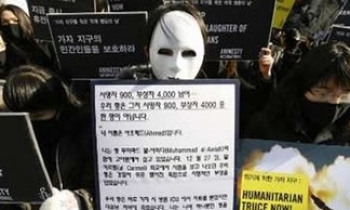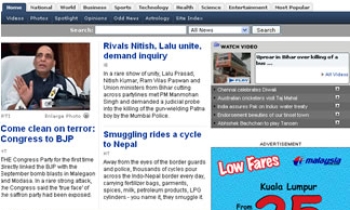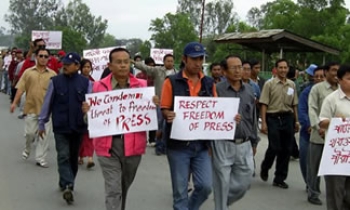The “missing” journalist from the tribal areas, Hayatullah Khan Dawar, has been murdered. His body was found on Friday, seven months after his kidnapping from the mountains about six kilometres south of the town of Mir Ali in North Waziristan Agency. Mr Dawar is the third journalist to be assassinated in the tribal areas since the operation began there, the earlier two having been killed in Wana in February 2005. Mr Dawar’s handcuffed body bore signs of a long and painful incarceration. The handcuffs and the bullet wound in the back of the head show he was executed. Who murdered him in cold blood?
Mr Dawar’s family says he told them, shortly before his kidnapping, that he was receiving threats from “security” agencies for reporting the facts on the ground. Mr Dawar became famous when he investigated the operation that killed the Egyptian Al Qaeda militant Hamza Rabia in Miranshah on December 1 last year. While the Pakistan government put out the story that Mr Rabia was killed in a blast caused by explosives located in the house in which he was hiding, Mr Dawar’s pictures showed that Mr Rabia was taken out by a Hellfire missile probably launched from a CIA drone. The pictures were widely distributed by the European Pressphoto Agency on the same day and showed the remains of what Western experts determined were parts of a Hellfire missile. The pictures contradicted the Pakistan government’s claim and, according to Mr Dawar’s family, he began getting threats from ‘certain quarters’; the political administration gave him three choices: leave the agency, stop reporting or accept a government job. Mr Dawar refused all three.
On December 5 last year, Mr Dawar was “grabbed by five gunmen who ran his car off the road in North Waziristan, near the Afghan border while his younger brother, Haseenullah, watched, unable to help”, says a report by the New York-based media watchdog, CPJ (Committee to Protect Journalists). At the time he was kidnapped, Mr Dawar was on his way to cover a demonstration of students against the US and the government for bombing and killing civilians with missiles from unmanned predators.
These are serious allegations by Mr Dawar’s family. More ominously, they seem plausible circumstantially. Two facts call out for a transparent inquiry into the killing. One, Mr Dawar was kidnapped within four days of Mr Rabia’s killing following his report the same day that Mr Rabia had fallen victim to a US aerial attack. Two, at least to the extent of his investigation into Mr Rabia’s killing, the Al Qaeda-Taliban elements in the area would have found the report favourable to themselves. This means that Al Qaeda may not have had reason to kidnap and kill Mr Dawar.
What is surprising is that whoever kidnapped Mr Dawar should have taken seven months to kill him. Why was he kept confined for that long and then finally killed? Were the kidnappers trying to cut some sort of deal with him to ensure that he would not be a troublemaker in the future nor spill the beans about who had kidnapped and tortured him, failing which they decided to get rid of him? Or did Mr Dawar get to know something in captivity that he was not supposed to know and which the kidnappers could not afford to make public? There are too many questions about this tragic case and they need to be answered.
But this is not all. It is obvious that the government is not coming clean on its operation in the tribal areas; it is equally obvious that it has some “understanding” with the Americans on how the latter’s forces can operate in hot pursuit of wanted elements or take them out when there is intelligence on Al Qaeda presence in the tribal areas. The problem is that whatever the nature of these arrangements, Islamabad, for political and other reasons, wants to keep things secret. In this context, journalists who are determined to unearth the truth are liable to be seen as a “bloody nuisance” or, worse, as a “security risk”. This is the context in which Mr Dawar’s reportage about Mr Rabia’s killing must have been seen by his kidnappers. The report went against the version of Pakistan and the United States and contributed in no small way to a mullah-inspired backlash against Islamabad and Washington. That must have made them mad as hell.
There is unrest in the tribal areas. The government has failed to tame the tribesmen and its own losses are increasing by the day. Repeated efforts to cleanse the area have failed. Continued secrecy has in fact redounded to the government’s disadvantage. When the truth has come out eventually it has been exaggerated by the opposition for maximum effect. Therefore, while operational details generally remain a secret, there is no reason to put a blanket on the entire policy of dealing with the threat of extremist elements.
The interior minister, Aftab Sherpao, has expressed “immense shock and grief” over the cold blooded murder of Mr Dawar. Oh yes? Mr Sherpao says the government will make all possible efforts to trace his killers. Of course it will. But what if it is confirmed that the finger is correctly pointed against some “security” agency or the other as alleged by the victim’s family? Will the government brush the evidence aside in the “national interest”? Will it heap one lie upon another to protect the “national interest”?
Of course, the national interest is supreme. But no state or non-state actor can be allowed by the public to claim a monopoly over defining the “national interest” and becoming an assassin in order to defend it outside the ambit of the law. That is why the press in Pakistan must protest loud and clear. It must not allow this case to be buried under officialdom and files. If it does, many more brave journalists will be kidnapped and killed for dubious state or non-state causes.









